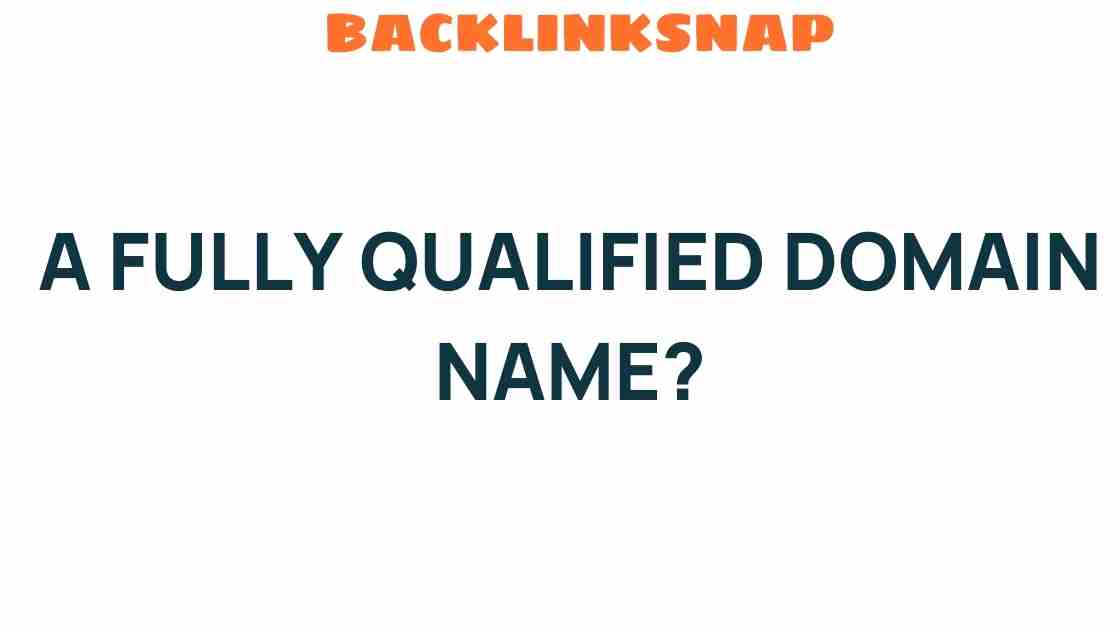Unraveling the Mystery of a Fully Qualified Domain Name
In the vast expanse of the internet, a Fully Qualified Domain Name (FQDN) stands as a crucial element in navigating the digital landscape. Understanding FQDNs is essential for anyone looking to establish an online identity, whether for personal use, business, or even educational purposes. In this article, we’ll delve deep into the intricacies of FQDNs, their relationship with the Domain Name System (DNS), and their role in shaping our digital presence.
What is a Fully Qualified Domain Name?
A Fully Qualified Domain Name (FQDN) is a complete domain name that uniquely identifies a specific location within the hierarchy of the Domain Name System (DNS). An FQDN provides the exact address needed to access a resource on the internet, making it integral to internet navigation. It consists of two main components: the domain name and the top-level domain (TLD).
For example, in the FQDN www.example.com:
- www is the subdomain.
- example is the second-level domain.
- .com is the top-level domain.
The inclusion of the subdomain (like “www”) is what makes an FQDN fully qualified, as it provides the complete path to the resource. This specificity is what allows users to navigate the internet effectively, ensuring they reach the correct destination.
The Role of the Domain Name System (DNS)
To appreciate the significance of a Fully Qualified Domain Name, one must first understand the Domain Name System (DNS). The DNS is akin to the phone book of the internet; it translates human-friendly domain names (like example.com) into numerical IP addresses (like 192.0.2.1) that computers use to identify each other on the network.
The DNS operates in a hierarchical manner, where each level of the domain name signifies a different part of the hierarchy. When you type an FQDN into your browser, the DNS is contacted to resolve that name into an IP address, allowing your browser to connect to the correct server and retrieve the requested web page.
Components of a Fully Qualified Domain Name
Breaking down the FQDN further, we can identify several key components:
- Subdomain: This is the prefix that precedes the domain name. Common examples include “www” for World Wide Web, but organizations can create various subdomains to organize their web services (e.g., blog.example.com).
- Domain Name: This is the unique name registered for the website, such as “example” in the previous instances. It’s what users generally associate with the brand.
- Top-Level Domain (TLD): This part of the domain name indicates the highest level in the hierarchy and includes common TLDs like “.com,” “.org,” and country-specific TLDs like “.uk” or “.ca.”
Importance of FQDNs in Online Identity and Digital Presence
In today’s digital age, a Fully Qualified Domain Name is much more than just a technical necessity; it’s a cornerstone of your online identity. Here are several reasons why FQDNs are vital:
- Brand Recognition: A well-chosen domain name can enhance brand recognition and credibility. It’s the first thing potential customers see, and it can influence their perceptions of your business.
- Search Engine Optimization (SEO): A relevant domain name can help in search engine rankings. Having keywords in your FQDN can improve your visibility on search engines, attracting more visitors to your site.
- Professionalism: A custom domain name conveys professionalism. It shows that you’ve invested in your online presence, which can boost trust among users.
How to Choose the Right FQDN
Choosing the right Fully Qualified Domain Name is an essential step in establishing your online identity. Here are some tips to consider:
- Keep it Short and Simple: A shorter domain name is easier to remember and type. Avoid complex spellings that could confuse users.
- Make it Relevant: Include keywords that reflect your business or content theme. This relevance can help with SEO and user expectations.
- Choose the Right TLD: While “.com” remains the most popular, consider other TLDs that may better suit your niche or audience, like “.org” for non-profits or “.edu” for educational institutions.
Common Questions About Fully Qualified Domain Names
1. What is the difference between a domain name and a Fully Qualified Domain Name?
A domain name refers to the main part of your web address, while a Fully Qualified Domain Name includes the complete path, including subdomains and the TLD.
2. Can I have multiple FQDNs for the same website?
Yes, you can create multiple FQDNs that point to the same website. This is often done for branding or marketing purposes.
3. How do I register an FQDN?
You can register an FQDN through a domain registrar. Choose a name, check its availability, and follow the registration process.
4. What happens if I don’t renew my FQDN?
If you fail to renew your FQDN, it may become available for others to register. You could lose your online identity if someone else claims it.
5. Is an FQDN necessary for all websites?
While it’s not mandatory, having a Fully Qualified Domain Name is highly recommended for establishing a professional online presence.
6. How does an FQDN affect my website’s security?
Having a secure FQDN (using HTTPS) helps protect user data and builds trust. It’s essential for e-commerce and sites that handle sensitive information.
Conclusion
In conclusion, a Fully Qualified Domain Name is not just a technical term; it’s the bedrock of your online identity. By understanding FQDNs, their components, and their significance in the digital landscape, you can make informed decisions about your web presence. Whether you’re a business owner, a blogger, or an educator, recognizing the importance of an FQDN will empower you to navigate the internet with confidence and professionalism.
For further reading on topics related to domain names, you may find this resource helpful. If you’re curious about the technical aspects of DNS and domain management, check out this guide for deeper insights.
This article is in the category SEO Optimization and created by BacklinkSnap Team




